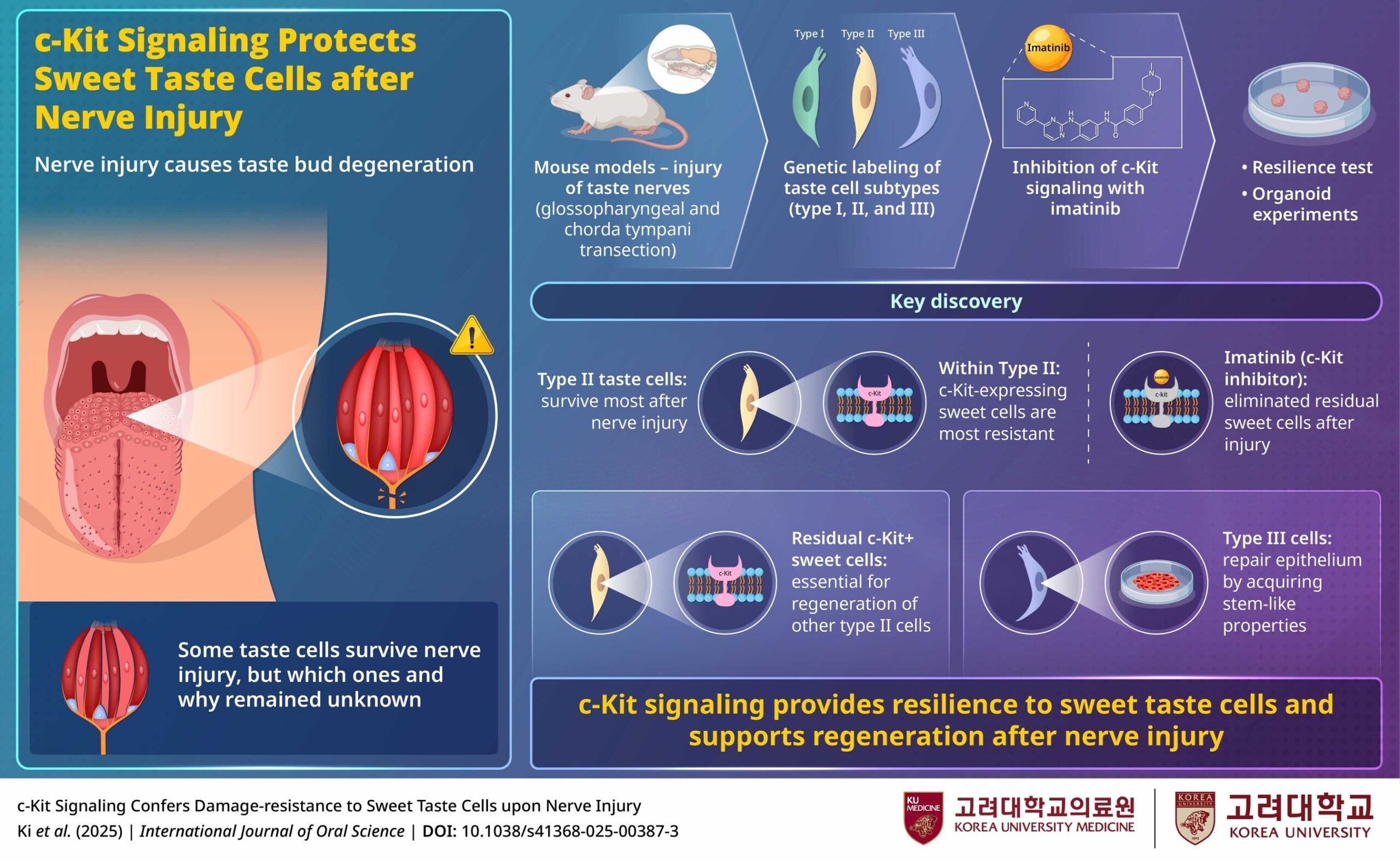Business
Researchers Uncover Key Protein That Protects Sweet Taste Cells

Research from Korea University College of Medicine has identified a critical protein that enables sweet taste cells to resist damage from nerve injuries. The study, led by Dr. Dong-Hoon Kim and Professor Yong Taek Jeong, was published in the International Journal of Oral Science on September 10, 2025, and offers new insights into taste bud regeneration.
Taste is an essential sensory experience that influences nutrition and overall well-being. Taste buds rely on their connection to nerves that transmit flavor signals to the brain. When these nerves are damaged, taste buds typically degrade but can regenerate as the nerves heal. The mechanisms behind this recovery process have long been unclear.
In their groundbreaking study, the researchers found that sweet-sensing taste cells utilize a protein known as c-Kit to survive nerve injuries. They demonstrated that when the c-Kit signaling pathway was inhibited using the cancer drug imatinib (marketed as Gleevec), the sweet taste cells vanished. This loss hindered the regeneration of other taste cells, indicating that c-Kit is crucial for both the survival of sweet cells and the recovery of taste buds.
Unlocking the Secrets of Taste Bud Recovery
Professor Jeong elaborated on their findings, stating, “Our taste buds consist of various cells that detect different flavors like sweet, bitter, salty, sour, and umami. It has been established that these taste buds are closely linked to our taste nerves, which transmit initial taste signals to the brain.” The study confirmed that when nerves to a taste bud are severed, the bud degenerates before regenerating alongside nerve repair.
The researchers utilized mouse models and taste bud organoids to test the resilience of taste cells. They found that c-Kit-expressing sweet cells consistently survived nerve injury. In organoid cultures, these cells continued to thrive even when survival factors were removed. The introduction of imatinib led to the disappearance of these sweet cells and delayed regeneration of taste buds.
Furthermore, the study revealed that other types of cells also play a role in recovery. Some Type III taste cells developed stem-like characteristics that assisted in repairing the epithelial lining around taste buds. This suggests that multiple cell types contribute to the recovery process: c-Kit-expressing sweet cells lead regeneration, while Type III cells aid in repair.
Implications for Future Taste Research
This research opens new avenues for understanding taste resilience and recovery. “This is the first discovery that allows us to selectively control specific types of taste cells. While immediate treatments are not yet available, it lays the groundwork for future exploration into taste disorders and nutritional improvements,” Professor Jeong emphasized.
The identification of c-Kit as a protective factor provides an explanation for why certain taste qualities persist longer than others in the face of nerve damage. This study not only sheds light on the complexities of taste bud regeneration but also sets the stage for future innovations in flavor science and medical applications related to taste.
For further details, the original paper can be accessed under the title “c-Kit signaling confers damage-resistance to sweet taste cells upon nerve injury,” with the DOI 10.1038/s41368-025-00387-3.
-

 Lifestyle3 months ago
Lifestyle3 months agoLibraries Challenge Rising E-Book Costs Amid Growing Demand
-

 Sports3 months ago
Sports3 months agoTyreek Hill Responds to Tua Tagovailoa’s Comments on Team Dynamics
-

 Sports3 months ago
Sports3 months agoLiverpool Secures Agreement to Sign Young Striker Will Wright
-

 Lifestyle3 months ago
Lifestyle3 months agoSave Your Split Tomatoes: Expert Tips for Gardeners
-

 Lifestyle3 months ago
Lifestyle3 months agoPrincess Beatrice’s Daughter Athena Joins Siblings at London Parade
-

 World2 months ago
World2 months agoWinter Storms Lash New South Wales with Snow, Flood Risks
-

 Science3 months ago
Science3 months agoTrump Administration Moves to Repeal Key Climate Regulation
-

 Business3 months ago
Business3 months agoSoFi Technologies Shares Slip 2% Following Insider Stock Sale
-

 Science3 months ago
Science3 months agoNew Tool Reveals Link Between Horse Coat Condition and Parasites
-

 Science2 months ago
Science2 months agoSan Francisco Hosts Unique Contest to Identify “Performative Males”
-

 Sports3 months ago
Sports3 months agoElon Musk Sculpture Travels From Utah to Yosemite National Park
-

 Science3 months ago
Science3 months agoNew Study Confirms Humans Transported Stonehenge Bluestones








